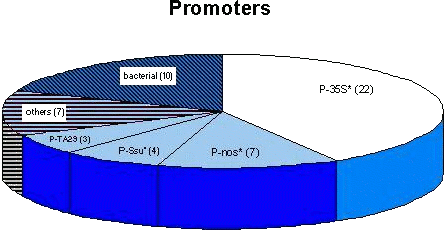|
You are here: Agriculture > Genfood and Food > Food from GMO > GMO Screening > Promotor
4.1.2 Survey of the promoters used
The expression of a new phenotype is dependent on various factors,
including the site of integration of the T-DNA whose location
may have an impact on processes such as gene silencing (P. Meyer,
1995). Alteration of the codon usage is a method frequently used
to optimise bacteria-derived transgenes for plant expression,
based on the redundancy of the genetic code and the distinct prevalence
of various codons and their respective t-RNAs in different phyla.
One of the most important factors for achieving the desired expression
levels of a transgene is the choice of the promoter that regulates
the transcription of the respective transgene. Many of the transgenes
that are present in 22 out of these approved genetically modified
products are regulated by the constitutive 35S promoter from the
cauliflower mosaic virus (P-35S = P-CaMV 35S) or by derivatives
of this promoter (e.g. with enhancer or duplicated). PCR-assays
detecting the presence of these promoter sequences appear to be
well suited for the development of detection methods (Figure 5,
Promoters in approved genetically modified agricultural crops and
Development of screening methods: Table 19).
The promoter from the nopaline synthase gene of Agrobacterium
tumefaciens (P-nos) has been used in 7 genetically engineered
products, whereas 4 products carry transgenes that are regulated
by variants from the ribulose-1,5-bisphosphate carboxylase promoter
derived from various plants. P-TA29 represents a tissue- and development-
specific promoter isolated from tobacco that drives expression
of one or several transgenes in 3 products. Seven genetically
modified crops contain still other promoters, while ten harbour
genes with bacterial promoters (Figure 5).
Some promoters until now have only been employed in single products;
however, the detection of internal sequences of these promoters
is generally not appropriate for detecting GMOs since many of
these, such as the tissue-specific promoters P-PEPC and P-CDPK,
originate from agricultural crops.

Figure 5: Number of occurrences of the most frequently
used promoters introduced into the currently approved genetically
engineered agricultural crops (in total 28 distinct products were
approved; see text). In some cases (indicated by asterisks) distinct
variants of the respective promoter were used (see
Promoters in approved genetically modified agricultural crops).
|





 antibodies on hand
antibodies on hand 